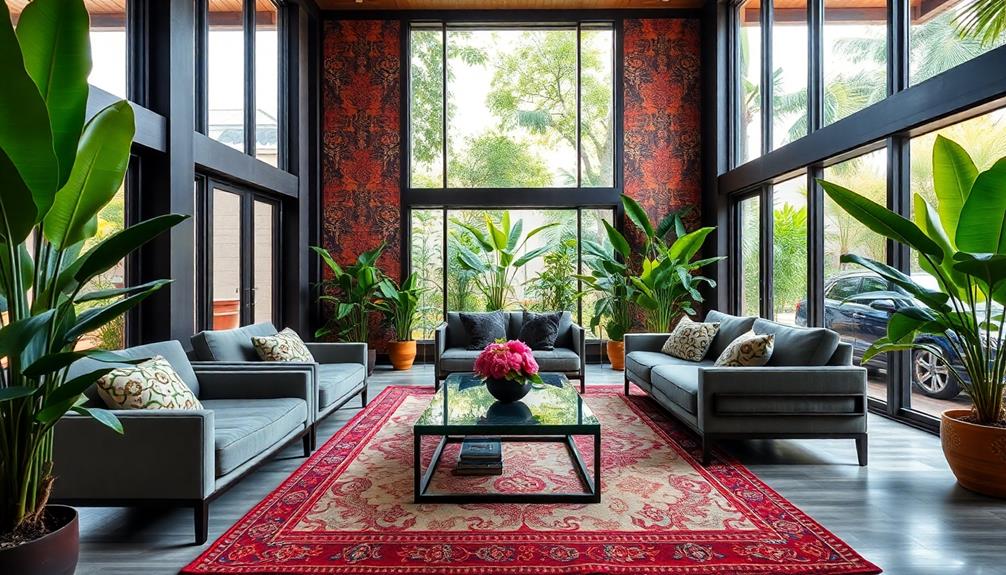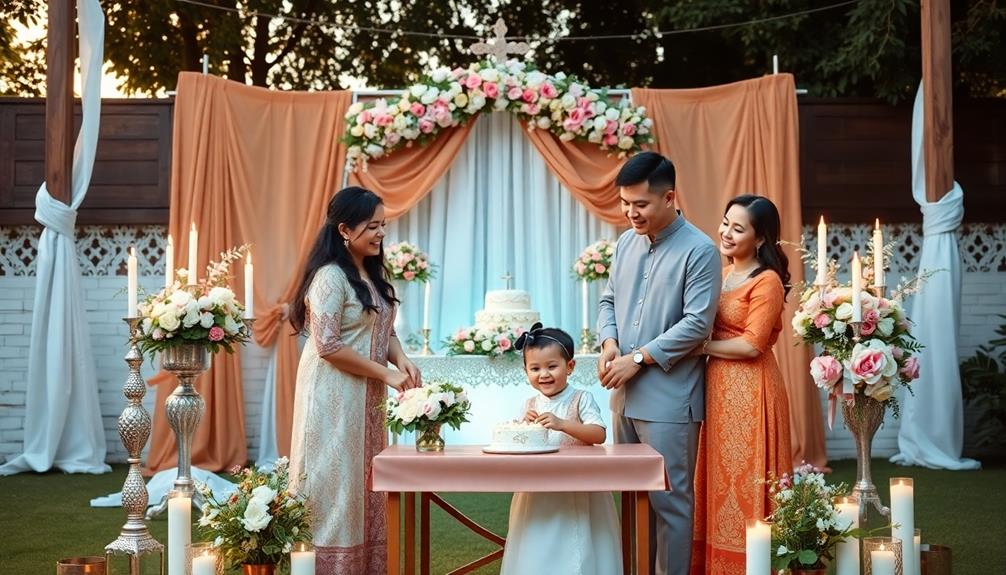Want to change your home's energy for the better? Start by clearing your entrance to promote positive chi flow. Next, optimize your furniture placement for an inviting and accessible layout. Use warm lighting to create a cozy atmosphere, and choose calming colors like soft blues and greens to reduce stress. Incorporate natural elements, such as plants and water features, to uplift the space. Don't forget to maintain cleanliness for a vibrant environment, and balance energy flow with thoughtful arrangements. These secrets work wonders, and there's even more you can discover to enhance your space.
Key Takeaways
- Keep your entrance clear and organized to enhance positive chi energy and create a welcoming atmosphere.
- Position furniture in the command position to promote security and facilitate smooth energy flow throughout the space.
- Use warm, layered lighting to create an inviting environment and improve overall energy flow in your home.
- Incorporate calming colors like soft blues and greens to reduce stress and enhance tranquility in your living areas.
- Add natural elements such as plants and water features to rejuvenate spaces and invite prosperity into your home.
Clear Your Entrance

Since the front entrance serves as the gateway for chi energy, it's essential to keep it clear and inviting. A clutter-free entrance not only enhances positive energy but also guarantees a smooth flow of chi throughout your home. To achieve this, designate specific areas for shoes, bags, and other items.
Consider incorporating vibrant Indonesian decorative pillows to add a touch of comfort and cultural heritage to your entryway, making it even more welcoming Indonesian Decorative Pillows. By storing these belongings out of sight, you prevent disruption of the energy flow at your entryway.
Additionally, maintaining a clean and organized space considerably improves the overall ambiance of your home. This contributes to feelings of peace and comfort for you and your guests.
Consider adding elements like red planters or decorative items to attract liveliness and enhance the energy flow. These touches make your entrance more welcoming and vibrant.
Don't overlook the visibility of your house number. Making sure it's clear and easy to see fosters positive first impressions and encourages lively chi circulation into your home.
Optimize Furniture Placement

When optimizing furniture placement, focus on strategic arrangements that enhance flow and accessibility, akin to the principles of Balinese design characteristics which promote a connection to nature.
Position your primary seating in a commanding spot, facing the entrance to foster a sense of control. By ensuring clear pathways and avoiding sharp corners, you'll create a harmonious space that promotes positive energy and encourages connection.
Strategic Arrangement Techniques
To create a harmonious flow of energy in your home, strategically arranging your furniture is essential. Start by positioning larger pieces, like sofas and beds, in a commanding position where you can easily see the entrance. This setup fosters a sense of security and control, key Feng Shui tips for enhancing your living space. You can also transform your home’s energy by incorporating natural elements, such as plants, water features, and natural light. These elements not only add visual appeal to your space but also promote a sense of balance and tranquility. By consciously arranging your furniture and incorporating natural elements, you can create a harmonious and inviting atmosphere in your home.
Incorporating elements from traditional Indonesian style home decor can further enhance the ambiance by utilizing natural materials that promote a connection with nature.
Make sure pathways remain clear and unobstructed to facilitate the smooth flow of positive Chi energy throughout the room. This approach not only enhances movement but also promotes accessibility.
Be mindful not to block natural light with your furniture arrangement, as this can create a stagnant atmosphere that disrupts energy flow.
Additionally, use furniture to create distinct functional zones within a room. This allows for various activities while maintaining overall energy flow.
Incorporating rounded furniture or pieces with soft edges can further enhance the space, as sharp corners pointing toward seating areas can create discomfort and disrupt positive energy.
Command Position Importance
Placing your furniture in a command position is essential for creating a tranquil and empowering environment in your home. This setup allows you to see the entrance without being directly in line with it, enhancing feelings of security and control.
Ideal furniture placement promotes an unobstructed view of the room, which fosters awareness and a sense of calm. Incorporating elements inspired by traditional Indonesian housing can further enhance this sense of serenity, as these homes often reflect harmony with their surroundings.
To achieve a command position, position your key furniture—like your bed or desk—away from doors and corners. This arrangement encourages smooth energy flow (chi) throughout your space. A solid wall behind your bed or desk signifies strength and protection, offering support and stability.
Avoid aligning your furniture directly with doorways, as this creates vulnerability and disrupts the positive energy in the room. Instead, create a layout that allows for an easy flow of energy while ensuring you can see incoming guests without facing them head-on.
Flow and Accessibility
Optimizing flow and accessibility in your home starts with strategic furniture placement that encourages movement and interaction.
To promote a smooth flow of energy (chi) throughout your space, create clear pathways that allow for easy navigation. Incorporating elements from luxury tropical design aesthetics can enhance the overall ambiance of your home.
Avoid oversized furniture that obstructs movement; instead, choose appropriately sized pieces that enhance functionality without crowding the room.
By utilizing vertical space with shelves and wall decor, you can maximize floor space while fostering a balanced layout that creates a sense of harmony. Arrange furniture in a way that encourages conversation and interaction, enhancing the positive energy flow in the room.
Additionally, consider the commanding position for key furniture pieces like sofas and beds. Place them where they can be easily seen from the entrance, fostering a sense of safety and control.
Keeping your space organized as possible will also contribute to a tranquil environment, allowing the energy to circulate freely.
Use Warm Lighting

To create a warm and inviting atmosphere in your home, focus on using layered light sources.
Incorporating natural materials and vibrant colors, as seen in luxury tropical designs, can further enhance your space's energy.
Aim for a color temperature between 2700-3000 kelvins to enhance comfort and relaxation.
Layered Light Sources
Creating a warm and inviting atmosphere in your home starts with layered light sources. By combining overhead lighting with table lamps and floor lamps, you can create depth and warmth, enhancing the overall energy flow of your space.
Integrating traditional artistry through decor like Indonesian masks can further enrich this ambiance. In feng shui, light plays a vital role in establishing a positive vibe, so consider using warm light sources within the 2700-3000 kelvins range. This promotes relaxation and makes your home feel cozy.
Task lighting is another essential element. It allows you to illuminate specific areas like reading nooks or workspaces, providing versatility for different activities.
Don't forget about natural light; incorporating windows and reflective surfaces boosts the atmosphere and reduces reliance on artificial lighting, further improving energy flow.
Adjustable lighting fixtures, such as dimmers, let you customize brightness levels to suit your mood and the time of day. This adaptability not only enhances functionality but also aligns with the principles of feng shui, ensuring your home's energy remains harmonious.
Color Temperature Importance
When you light up your home with warm lighting, you instantly transform the atmosphere into one that feels cozy and inviting. Warm lighting, typically between 2700 to 3000 kelvins, creates a comfortable atmosphere that promotes relaxation and enhances positive energy throughout your space.
Additionally, you can draw inspiration from Indonesian wedding decor ideas, which often utilize vibrant color palettes and natural elements to create an inviting ambiance. It's crucial to choose the right color temperature to influence your mood positively, making your home feel more welcoming and reducing stress.
Utilizing various lighting sources, like table and floor lamps, helps layer the light effectively. This approach reduces harsh shadows while enhancing the room's warmth and depth.
By incorporating adjustable lighting options, you can easily modify brightness levels to suit different times of day or activities, further enriching your living environment.
Strategically placing warm lighting highlights key areas in a room, drawing attention to decorative elements and contributing to a harmonious design. This thoughtful arrangement not only creates visual interest but also uplifts the overall energy of your home.
Embrace warm lighting as a crucial element in your Feng Shui practice, and watch how it transforms your space into a serene sanctuary.
Choose Calming Colors

How can the colors in your home influence your mood and wellbeing? Choosing calming colors is essential for creating a space that promotes tranquility and relaxation.
Soft blues and greens can help reduce stress and anxiety levels, making your home a sanctuary of comfort and safety. These hues not only enhance the energy flow within a room but also create an illusion of more space, contributing to a more inviting atmosphere.
Incorporating unique decor elements, such as a Face Indonesian Decor Mask, can further enhance the cultural richness and vibrancy of your space.
Warm, earthy tones are perfect for areas like bedrooms and living rooms, fostering a sense of security and peace. Meanwhile, shades like lavender and pale yellow can evoke calmness while stimulating creativity and positivity, making them ideal for workspaces or creative corners.
To achieve a soothing environment, guarantee your color choices have a consistent temperature, ideally between 2700-3000 kelvins. This balance, combined with appropriate lighting, enhances the calming effects of your chosen colors, allowing you to relax and recharge fully.
Incorporate Natural Elements

Incorporating natural elements into your home can transform your space and markedly enhance the flow of chi energy. By adding live plants, stones, and water features, you create a direct connection to nature that rejuvenates your living environments.
Emphasizing outdoor living areas, such as patios and decks, allows for a seamless changeover between indoor and outdoor spaces, tropical villa plans that invite a revitalizing atmosphere. Plants not only purify the air but also symbolize growth and renewal, making your living room feel more vibrant and calming.
Using natural materials like wood, stone, and bamboo introduces warmth and grounding energy, reinforcing the earth element in Feng Shui. This fosters stability and balance throughout your home.
To further elevate your space, consider adding a small water feature, such as a fountain or aquarium. Flowing water symbolizes abundance and wealth, inviting prosperity into your life.
Don't forget the power of natural light! Maximizing sunlight in your home enhances positive energy and creates a lively atmosphere. This not only maintains a balanced environment but also encourages the free flow of energy throughout your rooms.
Maintain Cleanliness

Maintaining cleanliness in your home is crucial for fostering positive chi energy. When your living space is clean and organized, energy flows freely, creating a vibrant environment that nurtures your well-being. Regularly decluttering spaces not only prevents stagnation but also promotes a positive atmosphere.
Consider these key benefits of cleanliness:
- A sparkling front entrance welcomes guests and positive energy.
- Clean surfaces and well-maintained appliances show self-care and promote harmony.
- Routine cleaning practices, like dusting and vacuuming, enhance overall energy circulation.
- Healthy plants purify the air, adding life and liveliness to your space.
Incorporating these habits into your routine will help you maintain cleanliness, ensuring that your home remains an inviting sanctuary.
By focusing on cleanliness, you're not just tidying up; you're actively inviting a flow of good energy into your life.
Balance Energy Flow

To create a harmonious living environment, it's essential to balance energy flow throughout your home. Start by ensuring clear pathways for movement; blocked areas can cause stagnant energy, preventing the free flow of chi.
Assess your space regularly and declutter to avoid attracting stagnant energy that hinders emotional clarity and overall well-being.
Next, pay attention to your furniture arrangement. Position pieces to create harmonious layouts, steering clear of sharp corners pointing toward seating areas, as these can disrupt positive energy flow.
Incorporating plants is another excellent strategy; they not only purify the air but also enhance and redirect energy, promoting liveliness in your home.
Consider using a bagua map to identify significant areas that may need adjustments based on the nine life areas it represents. This tool helps you pinpoint where to focus your efforts to improve energy flow effectively.
Frequently Asked Questions
How to Bring Positive Energy Into Your Home Feng Shui?
To bring positive energy into your home, declutter your entrance, add vibrant plants, use calming colors, position furniture for visibility, and fix any leaks or burnt-out bulbs. These changes promote harmony and enhance your space's energy.
What Is Bad Feng Shui for a House?
Bad Feng Shui creates chaos, blocks energy, and stifles happiness. Clutter overwhelms, mirrors push positivity away, sharp corners induce discomfort, and leaks symbolize loss. You need to address these issues for a harmonious living space.
How to Bring Good Chi Into Your Home?
To bring good chi into your home, clear clutter, incorporate plants, use a cohesive color palette, position furniture for safety, and maximize natural light. These steps create a welcoming atmosphere and enhance positive energy flow.
How to Improve House Fengshui?
To improve your home's Feng Shui, clear clutter, arrange furniture for a commanding view, use warm lighting, choose a cohesive color palette, and fix any leaks or broken items to enhance your space's energy and comfort.
Conclusion
By clearing your entrance, optimizing furniture placement, and using warm lighting, you invite positive energy into your home. When you choose calming colors, incorporate natural elements, and maintain cleanliness, you create a serene environment. Balancing energy flow throughout your space not only enhances your well-being but also transforms your living area into a harmonious sanctuary. Embrace these feng shui secrets, and watch as your home's energy shifts, your mood lifts, and your life flourishes.









